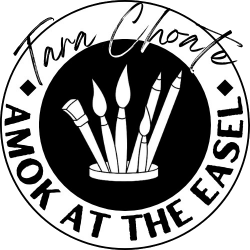With Ruth’s permission, I give you some of her feedback to my failure post on Sunday.
Regarding color options
“Interesting that the other workshop gave you the Brown Madder/Cobalt Blue colour scheme. I use a BM/Ultramarine mix often in painting (using CB if I want cooler), but also a rose madder/ultramarine or rose madder/manganese blue (manganese granulates more than cerulean). Using those as colour choices for this exercise is smart. Another, more way out, mix to try is Quin Gold/cobalt violet deep or mineral violet, and a John Singer Sargent standard is Alizarin Crimson/Viridian. He also used raw or burnt sienna with cobalt blue.”
Regarding edges
“For the edges issue try a value sketch first. A VERY quick sketch simplifying shapes (KISS) and then use only THREE tones: white (paper), mid and dark. It helps to draw 3 boxes at the side of the sketch and leave one white, lightly shade the second = midtown, then heavier shade the 3rd = dark. Map out your midtones (you can also use the midtone over the dark areas) and shade over the whole area without reference to the form of the subject, then add the darks in the same way. Look at the design of the piece rather than the subject – subject in this case being the horse’s legs. Look for movements of linked tones over the whole piece.
You can also try the pears exercise (where we divided the image into 3 parts) that we did on day one of the painting workshop on this more complicated image.
REMEMBER PROCESS NOT PRODUCT. An exercises shows its value in the resultant effect on your work, not in the exercise itself.”
Regarding underpainting and fuller painting
“Take a look at the demo piece I did as underpainting on Saturday. It is underpainting rather than limited palette so the ultramarine/rose madder is used as a varying mix rather than as two colours, but it was used to demonstrate looking for those design elements and lost edges.
For application to a fuller painting take a closer look at ‘Oil On Water‘. it is one of your favourites and this is probably why. Look at the handler’s feet and how they merge with the grass. Look at how the ‘line’ between horse and handler is suggested, then lost, then suggested again at his quarter and how the edge between her jeans and the bag is lost altogether. Those are design elements that add atmosphere and reduce clutter thereby helping focus the viewer on the important parts of the painting.”
My response
Thanks, Ruth! I will try not to whine about more value sketches. 😉
